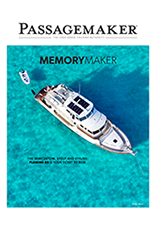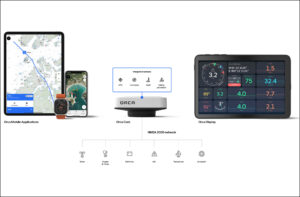James and Jennifer Hamilton radioed the Coast Guard before approaching the bar at Wide Bay on the east coast of Australia. The month was September, and the Hamiltons were aboard their Nordhavn 52, Dirona.
“They (the Coast Guard) said nobody has crossed that day, but they did expect it would be rough and speculated it must be rough out where we are as well,” Hamilton writes in the couple’s blog. “We agreed, it definitely was lumpy. They said we might be happier in than out, but neither would be easy right now.”
Hamilton says the entrance to Wide Bay was clearly evidenced by a gap between breakers on either side. They judged the bar to be “crossable.”
Navigating the entrance, however, they noticed a wave building behind them. “We rose about a third of the way up the wave as it passed underneath before getting hammered by the break from above,” he says.
“Dirona was driven back down the wave by the breaking section fast and, as we headed down, the stern very slowly accelerated more quickly than the bow and started to swing off course to the right. We now were at full throttle and full right rudder, but the stern continued to get driven around the forefoot towards the starboard side by the breaking wave from above.
READ MORE: Click Here To Visit The Hamilton’s Blog And Follow More Of Dirona‘s Adventures.
“The boat rotated broadside into the wave, the wave continued to drive it down and the boat slowly rolled away from the wave. At this point we could hear the furniture ‘pouring’ into the starboard side of the boat. We didn’t really feel that far heeled over but gravity definitely was creating a mess in the salon behind us.
“When the wave had passed, the boat was popping up, but the wave’s twin was close behind and also breaking. We turned the boat back towards the shoreward path we were on earlier as the second wave hit hard from above.”
Bilge alarms flashed, and Hamilton saw that water from knockdown was up to the oil pan of the engine. It had come in through the starboard air intake grill as the wave hammered down on the heeled over boat from above. The boat was quickly dewatered with a powerful hydraulic bilge pump. The satellite compass measured the worst roll at 69.1 degrees.
Hamilton described minor damage to hardware due to the press of seawater and some component failure due to immersion. “The list of faults we did take is not insignificant but it feels like a bunch of minor scrapes and nicks,” he says.
Hamilton says they re-learned a few lessons that day.
“Looking specifically at river bars where these conditions are common, we have long known that waves appear smaller from the backside than from the landward side. So it’s important to keep this in mind when assessing conditions. It’s difficult to turn around fast enough in a narrow channel between big waves so it’s important to make the decision early enough,” he says.
“And, what we learned in this case arguably we already knew but this certainly drives it home, wave sets vary greatly in size. If there is a respectable period of non-breaking water in a channel, it doesn’t mean that you won’t find a larger set of waves when transiting. We would have been well served by studying this entrance for longer from seaward since breaking seas can be so dangerous.”

An excerpt fromwww.mvdirona.com, a blog maintained by owners James and Jennifer Hamilton, was contributed to this report. The photos both here and appearing in print are those of the authors. The original posting can be found here.







